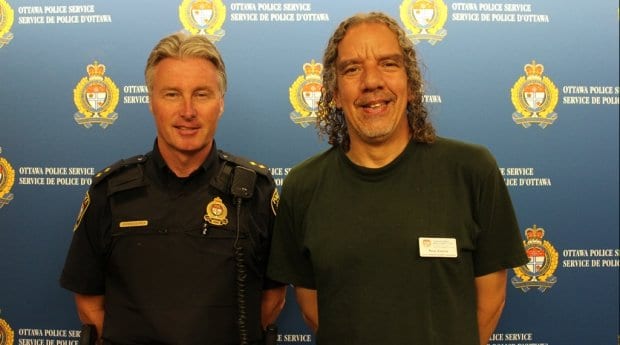The issue of the Pride cruiser sparked a contentious debate in an otherwise quiet meeting of the Ottawa Police Service’s GLBT liaison committee.
Back from the summer break, the liaison committee met on Sept 21, 2015, and went through the agenda with record speed until the Pride cruiser came up in conversation. The Pride cruiser — an Ottawa police car decorated with Pride rainbows — was unveiled in August.
During a debrief of the Capital Pride celebrations, police officers said the Pride cruiser was well received by the public. Other attendees voiced their support, but Jeremy Dias, executive director of the Canadian Centre for Gender and Sexual Diversity, shared his concerns.
“I hate to be that guy,” Dias said. “The people I work with hated it. It was a thousand dollars. It was a giant waste of money. It’s been decommissioned already. We’re never going to see it again.”
A discussion followed on what was happening to the Pride cruiser. Attendees had heard different reports, but Staff Sergeant David Zackrias, head of diversity and race relations, clarified the fate of the car after the meeting.
“The Pride cruiser was a one-time initiative to commemorate the 30th anniversary,” Zackrias said in an email to Daily Xtra. “The cruiser was turned over to the fleet section.”
During the meeting, Dias said there are more effective ways to engage with community members who feel unsafe around police officers.
“Michael Burtch, an activist in our community, really summed it up on his Facebook site,” Dias continued. “He said neither did the police offer an apology for decades of violence. Neither did the police donate to the rising costs of Pride. They put a rainbow on a police car, which is great, which is super, super great, but it’s not responding to the needs [of the community].”
Police pointed out it isn’t in their mandate to donate money to organizations.
“This decision to commemorate 30 years of Pride in Ottawa was my section’s decision,” Zackrias said. “That was our way of sort of showing support to the community.”
In an interview with Daily Xtra, Zackrias said while he’s open to suggestions, the community hadn’t been consulted in advance of the initiative because the Pride cruiser was intended to be a surprise. Zackrias, who’s the liaison committee’s police vice-co-chair, said he’s willing to talk to people who have concerns but stands by his decision to spend $1,300 to outfit a Pride cruiser. He also said he’s received a lot of positive feedback from the public.
For Dias, the car was a “beautiful gesture” but said it’s important the liaison committee doesn’t forget that many of the LGBT community’s most marginalized members still fear and mistrust police officers.
“The people I get to work with — the homeless kids, the sex-work kids, the more marginalized folk — they see a cop, that reminds them of the cop who pushed them around when they were in high school,” he said. “They don’t see the people; they see the uniform.”
For people who have been mistreated by police, seeing a rainbow police car during Pride isn’t necessarily going to build bridges, Dias said. He questioned if there weren’t more effective ways of reaching out to marginalized people who feel mistrustful of police.
“We’re not perfect, but this was a gesture to show our goodwill and can we please 100 percent of the people all the time?” asked Inspector John McGetrick, police co-chair of the liaison committee. “I guess not, but the impression I’m getting, Jeremy, is the majority were happy with it.”
McGetrick also asked Dias if he could bring people who have concerns to initiatives like Let’s Chat, an informal gathering for community members to interact with police officers. When police officers hear directly from community members, it gives police an opportunity to improve, McGetrick said.
The liaison meeting also included the election of a new community co-chair. Peter Zanette, the only person who put his name forward, was voted in to replace Gary Leger, who recently resigned because he moved to Toronto.
The liaison committee currently is without a community vice-co-chair. The position will be filled during the election at January’s annual general meeting.


 Why you can trust Xtra
Why you can trust Xtra


